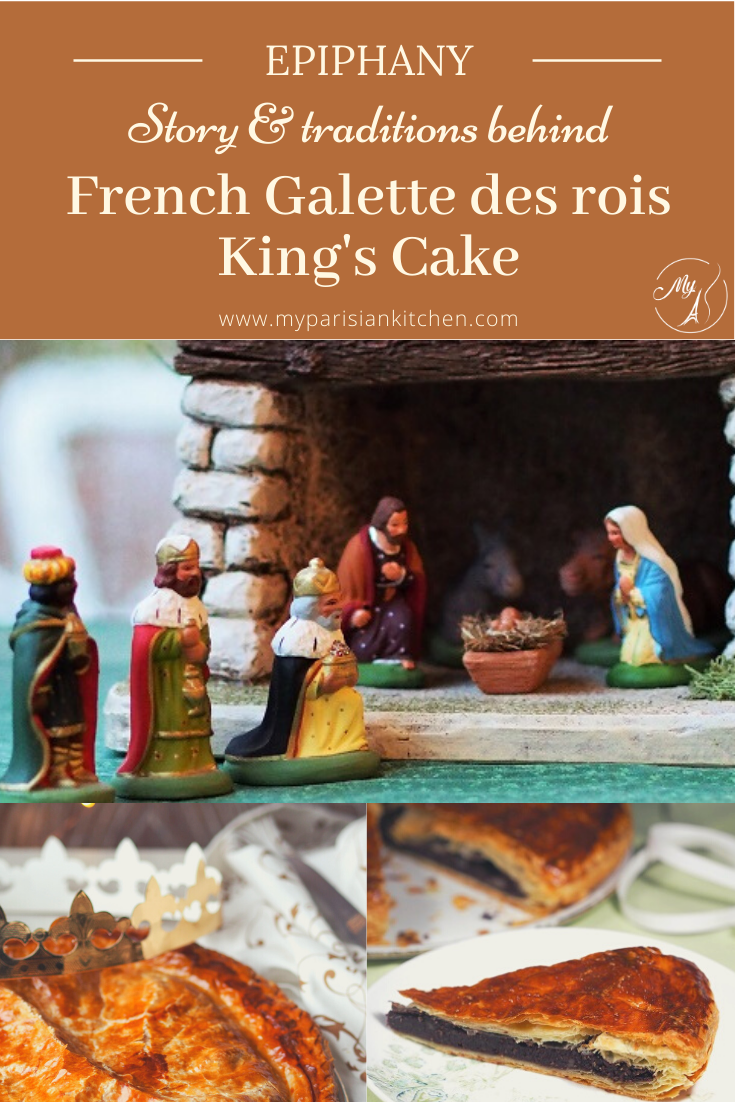Do you know where the tradition of eating a king cake , or should I say Tart of the kings? – called galette des rois in French – at Epiphany day comes from? Why drawing a bean or a lucky charm? Will you have a galette or a brioche?
First of all, the story
Even if Epiphany was celebrated for a long time on January 5, 12 days after Christmas, we now eat king cake on the first Sunday of January (and often during the whole month of January!)
Epiphany commemorates the visit of the Three Wise Men – Magi Melchior, Caspar, and Balthazar – from the East to Bethlehem, following the bright star sawn the sky on the day of Jesus’ birth. Their journey lasted 12 days before they could celebrate baby Jesus’ venue and offer him gifts.
The Catholic Church officially declared Christmas Day on December 25 in 336 AD, thus making it coincide with the ancient popular pagan celebrations having all kinds of old rituals related to winter solstice (celebrating days getting longer and the return of the sun during 12 days).
Around the 13th and 14th centuries began the first Epiphany cake-sharing tradition (shares for everyone present plus one, saved for the poor). The tradition of sending the youngest child, supposedly the most innocent, shall also come from that time (or from ancient Rome, everyone does not agree here).
Galette or brioche?
King cake, traditionally called galette des rois in French whatever it may be has various shapes, types of cake, and flavors depending on the region and local traditions. But of all stories, there is one that gave it its name to it, the galette.
In the 16th century, the king cake was the subject of a fierce war between bakers and pastry chefs, each wanting a monopoly on its sale, already feeling it could become a lucrative market. King Francois the 1st granted the right to Pastry chefs. Bakers skirted their ban on selling king cakes by replacing them with galettes that they offered to their customers.
In Paris, king cake was a mixed with the Pithiviers cake to become a galette of puff pastry filled with almond frangipane. In Southern France, it is an orange blossom flavored brioche with candied fruit. In the Alps, the galette of my childhood was a generous brioche with huge pink pralines. I wonder if there is a complete list of all the different king cakes served across France somewhere. I promise that I will start my tour of France’s regional king cake recipes next year.
And what about the bean? Today, no galette des rois without a lucky charm
The tradition comes from the 14th century when, for the first time, in Besancon (Eastern France) monks began to elect their chief chapter by putting a gold coin in a piece of bread. The bread was then replaced by a brioche crown (were they gourmets?), and gold coin by a bean (cheaper!).
This tradition has developed rapidly in all layers of the population. Or was it a memory of old customs? In Babylon, as a slave, he drew lots of royalty, becoming king of a day (but being killed at the end of his reign), and in Rome during Saturnalia (celebrating the god Saturn) during the winter solstice: during one day, masters and slaves were on treated as equals – they even ate at the same table -, a king was elected for the day. The king could achieve what he wanted and give pledges.
Then, under King Louis XIII, the ladies of the court used to draw lots. The winner became the queen for a day and could request a vow to the king. This was quickly abolished by his successor Louis XIV.
In the same period (14th century), the custom of “the king drinks” appeared. Whoever got a piece of cake with a bean inside had to offer a drink to the whole assembly. It is said that the stingiest used to swallow the bean without paying. Thus, porcelain charms appeared, as they were more difficult to swallow. The real beans were replaced by porcelain figurines representing Jesus in the 18th century (and a Phrygian cap during the French Revolution and nowadays all kinds of things).
Actually, the first beans were put in king cakes because they were a symbol of fertility (the bean is the first vegetable growing in spring after the winter solstice).
This tradition continues in France of course, but also in Spain, Portugal, Belgium, Switzerland and Germany. You may read me abroad. Is there an after Christmas tradition in your country? What is it?
And do you have a collection of porcelain lucky charms? Which is the most original or awesome?
Galette des rois recipes to celebrate Epiphany




Find out more about French culinary traditions in a complete file: for instance, the story of Candlemas crepe day, why Christmas cakes have a yule log shape, what the French eat at Easter...
